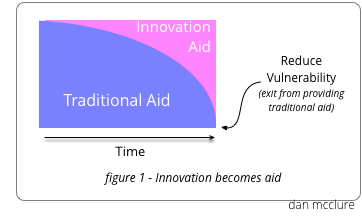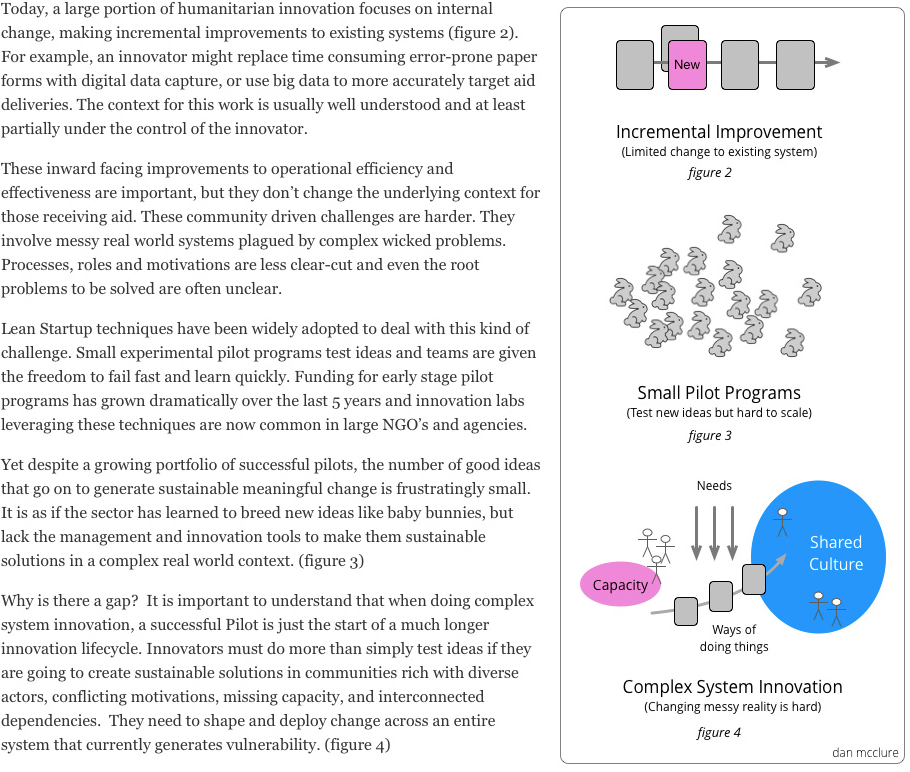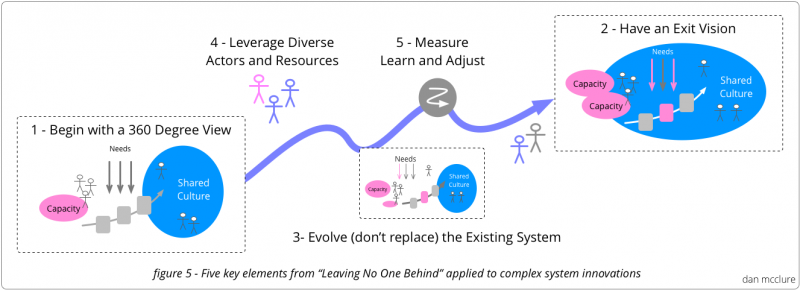In the fanfare surrounding the release of the Sustainable Development Goals it may be easy to miss a shift in thinking that can have a dramatic impact on the role of Humanitarian innovators. Our job as advocates and practitioners of innovation is about to get much harder … and more important.
In closing remarks at the recently concluded OCHA Global Humanitarian Policy Forum in New York, Hansjoerg Strohmeyer, Chief of the Policy Development and Studies Branch of OCHA, challenged the current humanitarian model, where extended displacements can run for 10 years using the same mode of operation.
He sees the Sustainable Development Goals as an opportunity to change this thinking. Simply meeting ongoing needs for the delivery of aid should no longer be enough. Humanitarians need to accept responsibility for scaling up local actors instead of just funding the sector’s own operations.
The themes are repeated in OCHA’s newly released report, Leaving No One Behind, Humanitarian Effectiveness in the Age of Sustainable Development Goals. The report reinforces the message that investments in aid often create humanitarian holding patterns, ultimately denying opportunities for self-reliance and real resilience. There is call for change. Reducing vulnerability and improving resilience needs to be seen as an essential component of humanitarian action.
Innovation Becomes Aid – Internal to External Focus
So, how does this change the role of humanitarian innovators?
At its heart, innovation is about changing the way that systems work. When calls are made to achieve the Sustainable Development Goals by progressively reducing the vulnerability of affected populations, what is really being said is that innovations are needed in the complex systems that surround a local context.

While traditional aid may dominate the early days of a crisis response, over time a shift must be made to evolve the underlying systems that create risk and fragility in the first place. In effect, innovation focused on serving local communities progressively replaces traditional aid as the most important component of humanitarian action.
It might well be argued that the development/humanitarian sector has long been working to address issues present in underlying community systems. Is this simply rebranding business as usual with an innovation label? The facts on the ground seem to argue against this view. Decade long humanitarian holding patterns are indicative of an ongoing failure to reduce long-term vulnerability. Innovators need to step up and contribute more.
Shifting from Internal to External Challenges
This should be an exciting opportunity for innovators to expand their impact in the field, but it is not one for which most are well prepared.

A Model for Leaving No One Behind
Where can an innovator find a roadmap for doing this externally focused complex innovation?
There is good news on this front. The OCHA Leaving No One Behind report lays out a high level framework for tackling complex system innovation. Echoing Mr. Strohmeyer’s comments, the report explores what it means to move away from “spending on activities and outputs at the expense of long-term sustainable impact.”
What makes the report particularly valuable for innovators is that Lesley Bourns and Jessica Alexander, working with a broad team in the OCHA Policy Analysis and Innovation Section, have defined five actionable strategies for making this shift. (The recommendations appear in the “How Do We Get There” section of the report, beginning on page 72. They have been paraphrased and renumbered here to facilitate discussion.)
- Begin with a 360 Degree View: Take a systems view of the challenge. Start with whole system perspective of risks and needs. (#3 in the original report)
- Work toward an Exit Vision: Enter with an exit strategy that ultimately reduces and ends humanitarian need (original report #2)
- Evolve (Don’t Replace) Existing Systems: Reinforce, don’t duplicate or replace existing capacities and coping strategies. Recognize the value of building on systems that are already in place. (original report #1)
- Leverage Diverse Actors and Resources: Work collectively. Leverage the comparative advantage of multiple actors and institutions, including those outside the Humanitarian system. Strengthen connectivity and strategic leadership. Don’t do it all yourself. (original report #4)
- Measure, Learn and Adjust: Measure shared results for cross system accountability. Don’t simple execute a series of individual plans. Learn and collectively adjust the path forward. (original report #5)
The five recommendations are not targeted solely at innovation teams. They are good general advice for advancing the SDG’s. However, since innovation is at the core of reducing systemic vulnerability, it shouldn’t be surprising that these five themes can be applied as a roadmap for guiding complex innovation within affected communities.
Embracing the Difficulty of the Work
Shaping innovative change in a complex local context is hard. Incredibly hard. The five-part model from Leaving No One Behind helps to keep the system level challenges front and center, providing principles for a high level practice (figure 5).

The journey begins with an embrace of the system nature of the problem (1). Real world communities come with a multitude of interconnected and interacting parts. Attempts to see change as a single point of action are doomed from the outset. The long line of failed cook stove innovations highlights the danger that comes with the hubris of point solutions inserted into complex systems of behavior, culture and economics.
The exit point is a systems view too (2). The SDG’s are not satisfied with unending cycles of aid. There needs to be an exit. However, the goal is not to simply stop the delivery of aid, but rather to shape an environment where vulnerability and the need for aid is vastly reduced.
Between these two holistic views is a process that evolves from one system state to the other (3). Innovators must evolve new capabilities and resilience within the context of a complex and interconnected system that already exists. They cannot pretend they start with a blank slate and simply replace all the broken parts.
This requires diverse talents and capabilities (4). At every point in the evolution there will be messy problems with multiple dimensions. It’s impractical to act alone. Innovators must actively engage the full range of capabilities within their reach and respect the contributions each can make.
And finally, even with all these skills at hand, there will be no clear path from beginning to end. Unexpected insights, constraints, and change will require continuous learning based on measurement (5). This is more than measurement to produce an evidence base. Each measure provides a new insight that helps guide the evolution of the system innovation.
An Important Journey with a Long Way to Go
The Sustainable Development Goals call for lasting reductions in vulnerability rather than simply continuing to serve immediate needs. There’s a lot to do. If the sector is going to seriously take on this task it must provide affected communities with complex innovation support, drawing on an organizational capacity that is still extremely limited.
Innovators should (and likely will) welcome the opportunity to step up their contributions, but there is still a long way to go on this journey. Recognizing the scale of the shift and admitting the gaps are good first steps. The challenge is then to build the models of practice that enable the externally focused complex innovation that the SDG’s require.
About the Author
Dan McClure has spent 30 years designing and applying innovation practices across a diverse range of enterprises. He specializes in the architecture of sustainable systems of creative innovation. Today, he leads Innovation Design initiatives for ThoughtWorks, where his clients include humanitarian and public good organizations working to advance their ability to drive disruptive change.
Photo Credit: Asian Development Bank
We’re always looking for great stories, ideas, and opinions on innovations that are led by or create impact for refugees. If you have one to share with us send us an email at [email protected]
If you’d like to repost this article on your website, please see our reposting policy.

